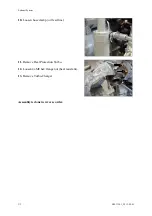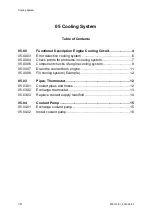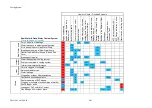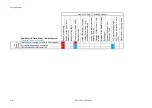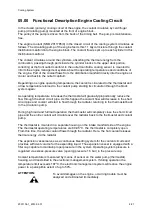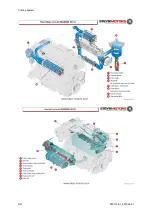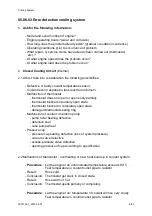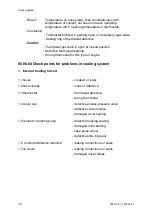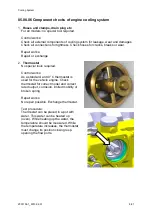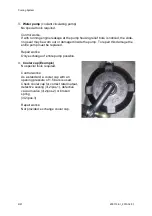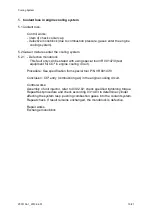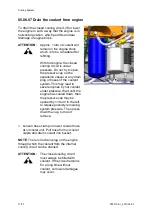
Cooling System
Z001138-1_2013-02-01
4/21
05.00 Functional Description Engine Cooling Circuit
In the closed (primary) cooling circuit of the engine, the coolant circulates by centrifugal
pump (circulating pump) mounted at the front of engine block.
The pulley of the pump is driven from the back of the timing belt. The pump is maintenance-
free.
The engine coolant (SMO Z011785/0) in the closed circuit of the cooling system circulates as
follows: The circulating pump of the engine feeds this 1:1 Glycol mixture through the coolant
distribution manifold into the engine block. The coolant flow is split up to each cylinder in this
distribution manifold.
The coolant circulates around the cylinders, absorbing the thermal energy from the
combustion, passing through ports inside the cylinder blocks to the upper deck portion
collecting at the front outlet manifold. In the outlet manifold a cooling sensor is mounted to
inform the engine management system about the operating temperatures and conditions of
the engine. Part of the coolant flows from the distribution manifold directly into the engine oil
cooler and back to the outlet manifold.
Depending on engine operating temperature, the coolant is circulated to the thermostat and
at low temperature returned to the coolant pump starting its circulation through the block
system again.
As operating temperature increases the thermostat will gradually/proportionally reduce the
flow through the short circuit pipe. As this happen the coolant flow will decrease in the short
circuit pipe and coolant will start to flow through the radiator returning to the thermostat back
to the circulation pump.
During high load and full load operation the thermostat will completely close the short circuit
pipe and the entire coolant will circulate over the radiator back to the thermostat and coolant
pump.
The thermostat is mounted in a separate housing on the intake manifold side of the engine.
The thermostat operating temperatures are 80-95 °C. the thermostat is completely open.
From this time, the whole coolant flows through the radiator. Here, the hot coolant releases
thermal energy via the radiator.
The expansion vessel serves as a continuous bleeding system for the coolant circuits and
provides sufficient volume for the expending liquid. The expansion vessel is equipped with a
filler cap capable to maintain proper pressure in the system. Operating system pressure is
regulated via excess-pressure valve (opening pressure 1.5 bar) in the pressure cap.
Coolant temperature is measured by means of sensor on the water pump (thermostat)
housing, and transmitted to the electronic management system. If during operation the
temperature limit exceeds 107°C, the electronic management system will reduce the engine
power to a perceptible extent of up to 50%.
ATTENTION:
To avoid damages on the engine, occurring trouble must be
analyzed and eliminated immediately.
Summary of Contents for Marine Engine 2012 Series
Page 35: ...General 35 65 Z001138 1_2013 02 01 Trouble Indication ...
Page 36: ...General Preliminary Service Manual MARINE 2012 Z001138 1_2013 02 01 36 65 ...
Page 51: ...General 51 65 Z001138 1_2013 02 01 G Notes on safety ...
Page 69: ...Engine Z001138 1_2013 02 01 4 87 Kapitel MOUNT BRACKET COVER T BELT GASKET SET ...
Page 154: ...Fuel System Z001138 1_2013 02 01 2 51 ...
Page 159: ...Fuel System 7 51 Z001138 1_2013 02 01 03 00 03 Unit injector ...
Page 190: ...Fuel System Z001138 1_2013 02 01 38 51 Schema Injection Timing Device ITD ...
Page 211: ...Cooling System 5 21 Z001138 1_2013 02 01 ...
Page 231: ...Electrical System Z001138 1_2013 02 01 4 47 ...
Page 235: ...Electrical System Z001138 1_2013 02 01 8 47 ...
Page 236: ...Electrical System 9 47 Z001138 1_2013 02 01 ...
Page 238: ...Electrical System 11 47 Z001138 1_2013 02 01 ...











